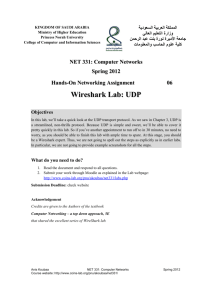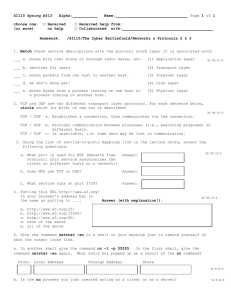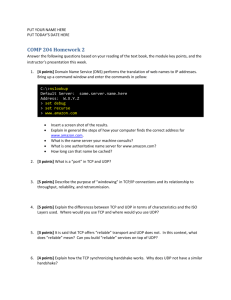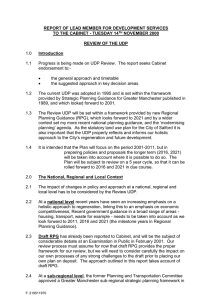PART 1 ITEM NO. (OPEN TO THE PUBLIC)
advertisement
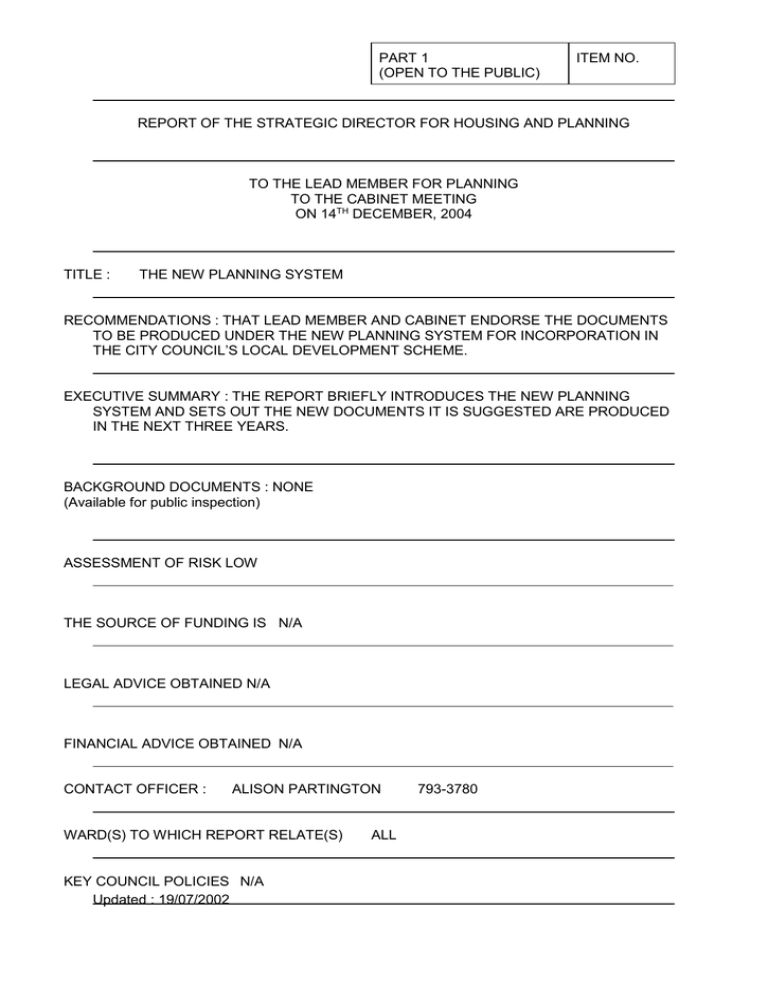
PART 1 (OPEN TO THE PUBLIC) ITEM NO. REPORT OF THE STRATEGIC DIRECTOR FOR HOUSING AND PLANNING TO THE LEAD MEMBER FOR PLANNING TO THE CABINET MEETING ON 14TH DECEMBER, 2004 TITLE : THE NEW PLANNING SYSTEM RECOMMENDATIONS : THAT LEAD MEMBER AND CABINET ENDORSE THE DOCUMENTS TO BE PRODUCED UNDER THE NEW PLANNING SYSTEM FOR INCORPORATION IN THE CITY COUNCIL’S LOCAL DEVELOPMENT SCHEME. EXECUTIVE SUMMARY : THE REPORT BRIEFLY INTRODUCES THE NEW PLANNING SYSTEM AND SETS OUT THE NEW DOCUMENTS IT IS SUGGESTED ARE PRODUCED IN THE NEXT THREE YEARS. BACKGROUND DOCUMENTS : NONE (Available for public inspection) ASSESSMENT OF RISK LOW THE SOURCE OF FUNDING IS N/A LEGAL ADVICE OBTAINED N/A FINANCIAL ADVICE OBTAINED N/A CONTACT OFFICER : ALISON PARTINGTON WARD(S) TO WHICH REPORT RELATE(S) KEY COUNCIL POLICIES N/A Updated : 19/07/2002 ALL 793-3780 1.0 1.1 Introduction The Planning and Compulsory Purchase Act 2004 introduces a new planning system, which changes the plan making system in particular. For a period of a few years, as transitional arrangements work their way through, aspects of the “old” system (UDP& SPG) will continue to apply, but “new” documents will be required to be prepared almost immediately and eventually will replace all existing documents. 1.2 The purpose of the report is not to provide a comprehensive summary of the new system. Rather it is to indicate the important decisions that will need to be taken in the next few months as a result of the commencement of Part 1 & 2 of the Planning and Compulsory Purchase Act 2004 on 28th September 2004. In particular, is there general agreement to those plans and documents that will be produced, and is there general agreement to those masterplans that will not be translated into formal planning documents? 2.0 2.1 The New Planning System Under the new system, rather than having a single plan for the City (the UDP), the Council is required to develop a planning framework that will consist of a series of documents. Some of these documents will be formal plans that together will comprise the statutory development plan for the city; others will be supplementary documents that will provide policy guidance. Those documents that will form part of the statutory development plan will provide the framework for both planning applications and CPO’s. 2.2 The current adopted UDP will continue to be the statutory development plan for the city until the Review UDP replaces it when it is adopted in 2006. This Review UDP will gradually be replaced by the new documents as and when they are adopted. 2.3 Whilst the new system gives the Council the freedom to create the planning documents it sees as necessary, there are a small number of documents the Council is required to produce. These include: A Statement of Community Involvement which sets out how the Council will consult on planning documents and major planning applications; A Core Strategy which sets out the strategic vision and the spatial planning framework for the city. It will be accompanied by a “key diagram”, (akin to the current County Structure Plan arrangement). The Core Strategy cannot include site allocations; A Proposals Map which shows the locations where policies and proposals will apply; A Local Development Scheme which sets out the 3 year programme of plan production (and which gives GONW an active role in determining which documents we shall produce); An Annual Monitoring Report that monitors performance against that set out in the 3-year programme and the effectiveness of the plans themselves. 2.4 Under the new system plans will now be expected to provide the spatial planning framework for the city. This goes beyond traditional land use planning to bring together and integrate policies for the development and use of land within all other policies and programmes developed by the Council and its partners. The new system will therefore need to provide the spatial framework that will enable the delivery of Housing Market Renewal and the proposed Central Salford URC. 2.5 The Core Strategy is expected to provide the spatial expression for the Community Plan and close links will be required between the review of the Community Plan and the production of the Core Strategy. This could involve some combining consultation period on the draft Community Plan with the early consultation on the Core Strategy and using the same sustainability appraisal framework to assess both documents. 2.6 All the documents that are produced under the new system will be required to be accompanied by a Sustainability Appraisal that fully accords with the Strategic Environmental Assessment regulations, as part of the plan production process. A fundamental part of the Sustainability Appraisal will be the development and maintenance of a comprehensive information base against which the effects of the plans can be assessed and monitored. 2.7 An independent examination will be held into all documents that will form part of the statutory development plan for the City. This examination will not be into objections to the plan as at present, but will consider whether the plan is sound in terms of its content and the processes by which it was produced. 2.8 A key test into the soundness of the plan will be whether the plan is founded on a thorough understanding of the needs of the area and the opportunities and constraints which operate in the area. An essential requirement of the new system therefore is the need to prepare and maintain an up-to-date information (evidence) base. This has to include: The principal physical, economic, social and environmental characteristics of the city; The principal purpose for which land is used; The size, composition and distribution of the population; The communications, transport system and traffic of the city Any other consideration that may be expected to affect those matters. 2.9 The current information base that exists will not be adequate to meet the requirements of the new system and it will be necessary to ensure that adequate resources are in place to enable the creation and maintenance of a comprehensive evidence base to support plan production. 3.0 The Local Development Scheme 3.1 The first document that will need to be produced as part of the new system will be the Local Development Scheme. (A draft of this is attached) This will set out a 3–year programme (2005/6 – 2007/8) for plan production. This will identify the documents the Council considers to be the priority for production. The document will need to be formally approved by GONW and (through an SLA) by the Planning Inspectorate (PINS). The Council’s performance will then be assessed against the timetables set out in this document and therefore this will be a key document both for the assessment of Planning Delivery Grant and potentially for future CPA. It is essential therefore that it sets a realistic programme that can be delivered and that adequate resources are available to enable the programme to be delivered. The resources of the Housing & Planning Directorate will need to support this work. 3.2 A draft Local Development Scheme has been produced for the city, although at this stage guidance on the workings of the new system are still being produced by ODPM, which will refine the production of the final document. A number of discussions have already taken place with GONW to try and understand the new system and ensure that it can support the work that is going on in the city and these will continue over the next few months. 3.3 In developing the approach to the new system the fundamental concern has been to find the best practical solution to ensure that formal plans and supporting documents effectively support regeneration initiatives within the city. Consequently the draft LDS currently includes the production of a number of area based documents that will support the regeneration of these areas. 3.4 The first priority in the next 3-year programme will be to complete the production of the Review UDP, which is due to be adopted in the first half of 2006. 3.5 Beyond this the draft LDS currently identifies the following documents to be produced as part of the statutory development plan for the city. These may not all be completed within the 3-year period but work will have at least commenced on them within this timescale. The Core Strategy – as the key document that sets the vision for the city and to which all other documents must conform, it is essential that this is one of the first documents produced. Output from the Central Salford Regeneration framework (the international competition) will be incorporated into the Core Strategy. The Statement Of Community Involvement – it is required that this is one of the first documents produced. Lower Broughton Area Action Plan - will convert the current master plan work being undertaken by Countryside into a formal planning document to support planning applications and any CPO’s required. Pendleton Area Action Plan - will convert the proposed master plan work into a formal planning document to support planning applications and any CPO’s required. Weaste Area Action Plan - will convert the proposed master plan work into a formal planning document to support planning applications and any CPO’s required. Greater Manchester Waste Plan – an AGMA wide document to address waste management issues. Proposals Map – required to be revised each time a document that forms part of the statutory development plan is adopted. 3.6 In a number of regeneration areas, masterplans have already been produced, or are in an advanced stage of production, to guide regeneration. The draft LDS proposes to keep these outside the formal planning system for the time being. To incorporate them into formal planning documents would require considerable public consultation on an extensive range of options for an area when they have already been subject to extensive public consultation. The masterplans for these areas would still be a material planning consideration in the determining of planning applications, but they would not have formal development plan status, which would reduce their weight in determining planning applications and supporting CPO work. 3.7 It is suggested that the following masterplans will not be translated into formal planning documents: Lower Kersal & Charlestown (NDC area) Seedley Langworthy Higher Broughton (currently covered by SPG, however) Ordsall Chapel Street Strategy 3.8 In determining which documents to produce and which not to produce the following criteria were used: Is it a statutory requirement? Is there a commitment within the Review UDP to produce it? Does the Review UDP incorporate (at least) elements of the masterplan? Is it required to support regeneration activity in the city? Is it required to support CPO activity? Have masterplans already been produced that have involved extensive public consultation? 3.9 As initial work will be concentrating on producing the core documents and the area plans to support the regeneration work in the City, the parts of the Review UDP that are not replaced by these documents will be required to provide the ongoing policy framework. This will include for example many of the criteria based policies used to judge planning applications. Work to review these and to provide an updated document to cover these areas will be commenced within the following 3-year programme. 3.10 In addition a large number of supplementary documents that will provide more detailed guidance are also identified for production. A large number of these will replace existing guidance that will cease to have any formal status once the Review UDP replaces the adopted UDP. The supplementary documents that it is planned to produce are as follows: Greengate/Exchange – unlike the other area based documents it is anticipated that this will not require statutory status, as it will not allocate sites and there is greater policy support in the Review UDP for the work in this area than in others. This approach is subject to further discussions with GONW. Lower Broughton Design Code – will enable the design principles for the regeneration of this area to be established in advance of the Area Action Plan for the area being produced. Planning Obligations – to provide more detailed guidance on the use of planning obligations in the city – will include open space requirements and affordable housing issues. Salford Green Space Strategy – to give detailed guidance on the distribution of green space and to give planning status to the work already carried out on this topic. Nature Conservation and Biodiversity – to provide more detailed guidance on the implementation of nature conservation policies which is a commitment in the Review UDP. Mosslands – to provide guidance regarding specific issues relating to this area, including the Mosslands “heartland”. Housing Market – will provide more detailed guidance on the housing tenure and type we wish to see in the city than is currently provided in the UDP Ellesmere Park – to replace the guidance in the adopted UDP Broughton Park – to replace the guidance in the adopted UDP Broadoak & Hazelhurst – to provide detailed guidance for this area in a similar way as is provided for Ellesmere Park and Broughton Park. Design – to address design issues in the city. Design & Crime } House Extensions } to review and update existing SPG which will lose Trees & Development } its status when the adopted UDP is replaced by the Telecommunications } Review UDP Hot Food Take Aways } Recycling – to provide guidance regarding recycling facilities within new developments 3.11 In determining which documents to produce and which not to be produce the following criteria were used: Does existing SPG need to be updated so that guidance continues to be provided on this topic or has it already fulfilled its purpose? Is it required to support regeneration activity in the city? Is more detailed policy guidance required or is sufficient guidance provided in the UDP? Is it a priority given the limited resources available for producing documents? As a result, for example, it has been decided not to produce SPD’s for the 4 town centres in the city as it is considered that sufficient guidance is already provided within polices in the UDP and a SPD on Conservation Areas is not being produced as it is not considered to be the highest priority for production. Other SPD’s that cannot be produced at this stage include Green Design Guidance, Regional Parks and Flood Risk. 3.12 The new planning system allows authorities to produce documents jointly with other authorities. It is under this process that the joint Waste plan will be produced for all 10 districts in Greater Manchester. Further consideration will need to be given to whether other joint plans are required with neighbouring authorities. A particular issues (raised by Manchester in discussions) is whether it would be advantageous to produce a joint document for the “Regional Centre” involving Manchester, Salford and Trafford. It is not envisaged that a formal planning document for this area would be appropriate at this stage, although revised Regional Spatial Strategy (RSS) is likely to highlight this area’s “urban renaissance” as key to the North West’s future prosperity so more informal planning work between authorities will be very important. 3.13 The production of the various plans and documents listed above will put a great deal of pressure on our staff resource. A key test for each document must therefore be is it really needed! As far as possible we must limit the number of plans and documents that we are committing ourselves to producing. 4.0 4.1 Conclusions The Planning and Compensation Act has introduced a fundamentally new system of planning. Planning documents will be expected to provide the spatial framework for the city and as result they will have a central role in supporting the delivery of many of the Council’s major policies and strategies, and specifically they will have a major role in supporting the regeneration of the city. 4.2 Guidance on the new system is still emerging but the initial focus has been on ensuring that the documents produced support the delivery of these key programmes in the simplest and easiest ways. 4.3 The new system requires a high level of programme management and the Council’s performance will be judged against this. Adequate resources will therefore be required to ensure that the programme is delivered. Malcolm Sykes Strategic Director of Housing and Planning
